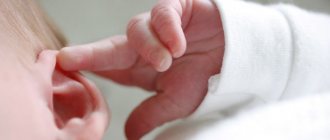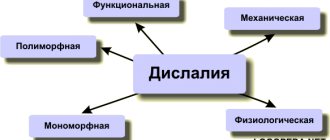WHAT IS PHONEMIC PERCEPTION?
Phonemic perception is the ability to perceive words through the perception of sounds, to determine how many sounds and syllables there are in a word, which consonant sound is at the end of the word and which one is in front, which vowel is in the middle, etc.
Sometimes parents come to see a specialist with the words: “My child has porridge in his mouth.” This is exactly how the speech of a child who has problems with phonemic perception is perceived.
When phonemic perception is formed correctly, the child will pronounce sounds and words correctly, the pronunciation will be clear and clear, he can easily learn to read and write, and will master the grammatical structure of speech.
The foundation for the development of phonemic awareness is considered to be the correct development of listening comprehension. Therefore, children who have problems with phonemic perception suffer from impaired auditory function.
The child’s vocabulary is not replenished with new words that contain sounds that are difficult to distinguish. It follows that the grammatical structure of speech is not formed.
In this regard, the child lags behind his peers in development.
In this article we will talk about age norms in ontogenesis and the stages of language phoneme acquisition.
Phonemic analysis and synthesis in ontogenesis
A. N. Gvozdev believes that the function of the child’s auditory analyzer is formed early, much earlier than the speech motor analyzer. Already in the second week of life, the child, hearing the sounds of a voice, stops sucking; stops crying when people start talking to him. He early distinguishes the sounds of the human voice and responds to this stimulus, depending on the intonation, either with a smile or a cry.
From 6 months, by imitation, he pronounces individual phonemes, syllables, imitating tone, tempo, rhythm, melody and intonation.
By the age of 2, children begin to distinguish quasi-homonym words (paronyms). By this age, the formation of phonemic hearing ends, as evidenced by the child’s phonemic discrimination of all the sounds of his native language. He is able to distinguish words by sound that differ by one phoneme.
In the process of early speech development, expressive and impressive speech are closely related: on the one hand, speech development stimulates auditory perception, on the other hand, it clarifies one’s own pronunciation.
LEVELS OF SPEECH PERCEPTION
Speaking about phonetics, there are two levels of speech perception.
| Phonemic (sensorimotor) level | Phonological (linguistic) level |
| This is the ability to distinguish speech sounds by ear and produce them through articulation. In essence, this is the general sound of speech. | Speech recognition at the phoneme level. The ability to determine the sound sequence and number of sounds in a word. |
The speech that a child hears is a rather difficult and unstable sound process. The child’s task is to find sounds and sound connections with the help of which one can distinguish the meaning of what is being said.
But the child must also be able to generalize speech sounds, this is called the semantic role of language.
Stages of speech perception
N.H. Shvachkin divides the process of speech perception into 2 stages:
- prephonemic (from birth to 1 year);
- phonemic (after one year, respectively).
Prephonemic stage. The child does not distinguish between phonemes and the sound-syllable structure of a word. At this stage, the child’s sound complex has several meanings. In other words, up to 1 year of age, the semantic load is carried not by the phoneme, but by the intonation, rhythm, and general sound pattern of the word. Moreover, up to 6 months, intonation plays a leading role, and at the 6th month, rhythm takes on a semantic orientation.
Phonemic stage. “Phonological development occurs rapidly, constantly ahead of the child’s articulatory capabilities, which serves as the basis for improving pronunciation.” Until this moment, the child recognized words by sound pattern, and from that moment he began to distinguish phonemes. First, contrasting ones, then complex ones, and lastly distinguishes between acoustically similar ones.
ONTOGENETIC FEATURES OF THE DEVELOPMENT OF PHONEMATIC PERCEPTION
In ontogenesis, phonemic hearing occurs spontaneously and at a very early age.
When a baby is two weeks old, hearing a noise or someone's voice, he stops crying, becomes quiet, or is distracted from the feeding process.
In the table below I will talk about age norms for the development of phonemic awareness.
| Pre-phonemic stage of speech development (speech understanding is not developed) | |
| Embryonic development | The ability to perceive speech sounds begins to develop. |
| 1-2 months | The child reacts to external noise vibrations: rattles, voices, melodies, etc. |
| 2-3 months | The child begins to look for where the sound is coming from: twisting his head, turning over in the right direction. |
| 3-6 months | The child already finds sound sources with his eyes, can distinguish voices, and determines the intonation of the voice (affectionate or strict). Reacts differently to calm and active melodies |
| Phonemic stage (language) | |
| 6-7 months | The baby no longer just hears different sounds, but learns to perceive the speech he hears. A large semantic role during this period is given to rhythm recognition skills. |
| 7-8 months | The child understands many words, including the names of the objects he sees. |
| 9-12 months | Along with recognizing intonation and rhythms, the child begins to extract a sound pattern that forms a word. |
| 2 years | At this age, the child understands and can distinguish words that differ in only one phoneme, for example, “Dew-braid.” The child develops a perception of speech sounds. |
| 3 years | The child is able to distinguish between vowels and consonants, hissing/whistles, soft/hard, sonorant sounds (voiced consonants with minimal noise) |
| 4 years | The child distinguishes all sounds. At this age, the formation of phonemic perception and pronunciation of sounds continues. |
| Final stages | |
| 5 years | Spontaneous phonemic development is completed. The child is able to distinguish between images of objects and sounds separately. |
| 6-7 years | Full awareness of the sound side of words comes |
The phonemic perception of sounds itself is formed as a result of the mutual connection of auditory and kinesthetic vibrations that enter the cerebral cortex.
Article:
The formation of the speech function in ontogenesis occurs according to certain patterns that determine the consistent and interconnected development of all aspects of the speech system (phonetic side, vocabulary and grammatical structure).
In its development, the speech function goes through a number of physiological stages, and in its completed form it is a physiological stereotype, a complex balanced system of connections that arise and strengthen during the development of the organism as a result of its interaction with the environment.
Regarding ontogeny, this idea was mainly developed by L.S. Vygotsky, A.E. Luria, emphasizing that the development of speech comes from diffuseness and differentiation in all components (vocabulary, grammatical structure, phonetics) and is socially conditioned.
The problem of the development of phonemic functions in ontogenesis was dealt with by such researchers as V.K. Orfinskaya [1946], N.Kh. Shvachkin [1948], R.E. Levin [1968], V.I. Beltyukov [1964, 1977], and others.
A child’s phonemic understanding of the sound composition of a language is formed on the basis of the acquired ability to hear and distinguish sounds (phonemic perception), identify sounds against the background of a word, and compare words by identified sounds (phonemic analysis). Since phonemic analysis, synthesis and representations are formed on the basis of phonemic perception, phonemic perception in the process of ontogenesis goes through certain stages of its development. VC. Orfinskaya [1946], N.Kh. Shvachkin [1948], R.E. Levin [1968], D.B. Elkonin, L.E. Zhurova [1963], E.N. Vinarskaya [1970], V.I. Beltyukov [1964, 1977], A.N. Gvozdev [1995] identify a different number of stages in the development of children’s speech, call them differently, and indicate different age boundaries for each stage. But it must be said that this division into periods is arbitrary and is introduced only for the convenience of studying the ways of development of children's speech.
So, for example, E.N. Vinarskaya [1970] distinguishes two levels of speech perception. The first level is phonetic (sensorimotor) - distinguishing speech sounds by ear and transforming them into articulatory images based on the preservation of acoustic and kinesthetic analysis. This level ensures the fullness of impressive and expressive speech.
The second level is phonological (linguistic) phonemic recognition of speech, establishing the sequence of sounds and their quantity.
N.Kh. shares the same opinion. Shvachkin [1948]. According to N.Kh. Shvachkin, the speech that a child hears is an extremely complex sound composition, a fluid and changeable process. The child faces the most difficult task - to single out from the entire sound diversity of living speech those sound relationships that play the role of meaning distinguishers in language.
The child must perform a very complex operation of not only isolating, but also generalizing the pronunciation auditory features of speech sounds. The basis for a generalization can only be the semantics of the language itself. Due to the fact that the child’s communication is mediated by words, he, gradually mastering the meaning of the word, begins to generalize sounds, forming a word. Through the word, the child moves to phonemic perception of speech.
Thus, N.H. Shvachkin identified two periods in the development of children's speech. Speech of the first period is pre-phonemic, prosodic speech, speech of the second period is phonemic. The author determined that the sequence of distinguishing speech sounds goes from distinguishing contrasting sounds to distinguishing increasingly similar sounds. First, the discrimination of vowels is formed, then consonants, since vowel sounds are more common and are better perceived. The distinction between the presence and absence of a consonant appears before the distinction between consonants. At first, the child distinguishes sonorant and noisy sounds in speech. Among noisy consonants, it begins to distinguish articulated noisy sounds earlier than others. At this stage, not only hearing takes part in the development of phonemic perception, but articulation also has an influence. Thus, in the process of speech development, the speech-auditory and speech-motor analyzers closely interact with each other. Underdevelopment of the speech-motor analyzer inhibits the activity of the speech-hearing analyzer. The child first distinguishes between hard and soft consonants that are articulated, and then those that later appear in speech. After this, the child learns differentiation within groups of consonants from sonorant to noisy. In the further development of phonemic perception, sounds different in the method of formation begin to be distinguished, primarily plosives and fricatives. Plosive consonants are distinguished and articulated earlier, since the presence of a stop enhances kinesthetic sensations in the process of articulating these sounds. Then the distinction between anterior and posterior lingual sounds appears. The difficulty in differentiating these consonants is explained by the inaccuracy of the kinesthetic sensations of the position of the tongue in the oral cavity.
At the next stage of phonemic perception, the child masters the differentiation of voiceless and voiced consonants. First, their acoustic differentiation occurs, on the basis of which pronunciation differentiation arises, which contributes to the improvement of acoustic differentiation. At this stage, a large role is also given to the interaction of the speech-auditory and speech-motor analyzers.
Later, in the process of developing phonemic perception, the child learns the differentiation of sibilant sibilants, smooth sibilants, and i (th). Hissing and whistling sounds in the speech of children appear late, due to their similarity in their articulatory characteristics, and differ only in the subtle differentiation of movements of the anterior part of the back of the tongue.
Another famous scientist is V.I. Beltyukov [1964] also studied in detail the formation of phonemic functions in the ontogenesis of speech. For example, he studied in detail the complexity of the interaction between speech motor and auditory analyzers in the process of developing phonemic hearing and explained it by the uniqueness of purely motor difficulties associated with mastering the articulation of certain phonemes and their differentiation in pronunciation.
IN AND. Beltyukov experimentally proved that by the end of the second year of life, the phonemic hearing of a normally developing child is already formed, however, to master the correct pronunciation, the child needs at least the entire third year, and sometimes several years. In addition, the sequence of mastering the pronunciation of phonemes and articulatory oppositions only partly, mainly in relation to vowels, coincides with the sequence of the formation of auditory differentiations. That is, the implementation of the auditory images and phonemes accumulated by the child in his pronunciation depends mainly on the specific course of development of the analytical-synthetic activity of his speech motor analyzer, on those stages of purely motor difficulties that include mastery of the articulation of certain phonemes and the ability to clearly mark them in pronunciation from each other and from all other phonemes.
Research by V.I. Beltyukov give reason to believe that the cause of this phenomenon can be considered the unclearness of auditory perception, when the speech motor analyzer has an inhibitory effect on the auditory one.
However, this can also be traced from the works of V.I. Beltyukova [1964, 1977], in the process of further development, the child masters the ability not to always take into account the articulation of sounds and to build sound images of words in accordance with their acoustic characteristics. These correct sound images, formed in accordance with auditory perception, stimulate the improvement of the child’s correct pronunciation. Thus, in the future, the auditory analyzer is freed from the inhibitory influence of the speech motor and this is facilitated by the development of the skill of comparing words (pronounced by the child himself and those around him by sound), i.e. development of elementary types of phonemic analysis, which contributes to the coordination interaction of analyzers.
IN AND. Beltyukov points out that after the babbling stage, the distinction between sonorant and noisy consonants (mom-dad, aunt-uncle) occurs first in children's words. He writes: “First of all, sounds are differentiated in children’s speech, the basis for the distinction is the opposition of the extension pipes: oral and nasal” [1977, p. 58].
Further, in children's speech there is a distinction between voiced and voiceless consonants (papa-baba). The contrast of sounds differs in terms of voicedness and deafness and is, apparently, the next differentiation of consonants in the developing speech of a child, and therefore relatively less contrasting than the previous one.
The next stage in the development of children's speech is characterized by the distinction in the pronunciation of plosive and fricative consonants.
R.E. Levina [1968] notes that the distinction between the lightest-sounding phonemes is established first, gradually spreading to acoustically closer sounds. Gradually, the child masters phonemes that differ little from each other in their acoustic properties (voiced-voiceless, hissing, whistling, r and l, etc.). The path of phonetic development of speech ends only when all the phonemes of a given language are mastered.
R.E. Levina identified the following stages in the formation of phonemic perception:
Stage 1) A complete lack of differentiation of the sounds of surrounding speech characterizes the pre-phonemic stage of development of linguistic consciousness and is accompanied by a complete lack of understanding of speech and active speech capabilities of the child.
Stage 2) Next, we can talk about the initial stages of phoneme processing, which is characterized by the differentiation of acoustically more distant phonemes and the undifferentiation of close ones. At this stage, the child hears speech sounds differently than we do. The language background of such a child corresponds to the sound images that he possesses and correlates with the capabilities of his perception. At this stage, the child’s pronunciation is incorrect, distorted, and corresponds to how he perceives speech.
Stage 3) This stage can be characterized by the fact that further shifts have occurred in the perception of surrounding speech. The child begins to hear sounds in accordance with the phonemic features found in the speech of others. Apparently, at this stage it is appropriate to talk about the existence of two types of linguistic background: the former tongue-tied and the formation of a new one.
Stage 4) In the fourth phase, new images of perception gain dominance in the linguistic background. However, linguistic consciousness has not yet completely supplanted the previous form. At this stage, the child’s active speech reaches almost complete correctness, which is still unstable.
Stage 5) The fifth stage marks the completion of the process of phonemic development. The child hears and speaks correctly.
Thus, mastering sound speech [according to R.E. Levina, 1968], occurs on the basis of acoustic discrimination of phonemes and the establishment of those phonemic relationships that are formed in the process of mastering speech.
Based on the facts presented, we can say that the differential features by which a phoneme is recognized by ear by people who speak speech without any distortion are the acoustic properties of these phonemes.
As for the differential features that underlie the subsequent acquisition of sounds in the act of speech, they are of an articulatory nature.
Phonemic analysis is a more complex function of the phonemic system. Phonemic analysis includes identifying sounds against the background of a word, comparing words based on the selected sounds, and determining the quantitative and consistent sound composition of a word.
Phonemic analysis not only recognizes and distinguishes words, but also pays attention to the sound composition of the word. Even with the most elementary types of phonemic analysis, words are compared by sound, sounds are isolated from the background of the word, etc. The formation of phonemic analysis is associated not only with the state of constantly practical functions, but also with the evolution of higher forms of cognitive activity, in particular thinking [D.B. Elkonin 1957]. This is confirmed by different periods of formation of phonemic analysis and perception skills in ontogenesis. In the process of ontogenesis, the development of phonemic analysis occurs gradually. Simple forms of phonemic analysis arise spontaneously during the development of oral speech in preschool age. Complex forms (determining the quantitative and consistent sound composition of a word) are formed in the process of special training.
There are several periods in the formation of phonemic representations. At the first stages (from one to three years), phonemic representations develop in accordance with their own incorrect pronunciation. In the process of further development, the child masters the ability to not always take into account the articulation of sounds, i.e. the auditory-speech analyzer is freed from the inhibitory influence of speech-motor analysis [V.I. Beltyukov, 1977].
Thus, the development of all phonemic functions in the process of ontogenesis goes through certain stages of its development. Normally, the activities of the functions of the phonemic system are carried out in unity and inextricable connection. References: 1. Beltyukov V.I. Interaction of analyzers in the process of perception and assimilation of oral speech. - M.: Pedagogy, 1977. - 176 p. 2. Beltyukov V.I. On children's acquisition of speech sounds. - M.: Education, 1964. - 91 p. 3. Vinarskaya E.N. Neurolinguistic analysis of the sound aspect of speech. // Language and man. - M.: Moscow State University Publishing House, 1970. - P.55-62. 4. Gvozdev A.N. Children's acquisition of the sound side of the Russian language. – M.: Aktsident, 1995. – 64 p. 5. Zhurova L.E., Elkonin D.B. On the issue of the formation of phonemic perception in preschool children. // Sensory education of preschoolers. - M., 1963. - P.213-227. 6. Orfinskaya V.K. On the education of phonological concepts in early school age. // Tr. LGIPI named after. A.I. Herzen, 1946, T.3. – P.44-52. 7. Fundamentals of the theory and practice of speech therapy. / Ed. R.E. Levina. – M.: Education, 1968. – 367 p. 8. Shvachkin N.Kh. Development of phonemic speech perception at an early age. // News of the APP of the RSFSR, issue 13. 1948. – P.101-133. 9. Elkonin D.B. Formation of the mental action of sound analysis of words in preschool children. // Reports of the Academy of Pedagogical Sciences of the RSFSR. Vol. 1. 1957. – P.107-110.
conclusions
Thus, the following conclusions can be drawn:
- The function of the child’s auditory analyzer is formed early, much earlier than the speech motor analyzer.
- Phonemic hearing consists of the ability to generalize different sounds into separate groups, to combine sounds, taking as a basis some essential features and ignoring other, random features.
- The process of speech perception is divided into two stages: prephonemic and phonemic.
- N. Kh. Shvachkin identifies 12 phonemic series according to the order of formation in children.
- Of all types of analysis of speech flow (dividing sentences into words, words into syllables, syllables into sounds), the most difficult is the phonemic analysis of words.
- Practical ideas about the sound composition of a language are formed on the basis of phonemic analysis and perception. Memory and attention play a significant role in this process.
Korchagina Larisa, teacher-speech therapist (St. Petersburg)
Probable Causes
The development of phonemic hearing is influenced by the upbringing environment, the example of speech in the family, the state of the peripheral nervous system, etc.
Among the most likely causes of the violation are the following:
- pedagogical neglect;
- hearing loss;
- head injuries, hearing and speech pathologies;
- hyperactivity;
- weakening of the body, serious or frequent illnesses, especially at an early age;
- diseases of the thyroid gland and digestive organs;
- neurological disorders.
To identify the exact cause, it is necessary to consult an ENT specialist, neurologist and speech therapist as early as possible. Sometimes, in addition to the development of phonemic hearing, drug or surgical treatment is required: cutting the hypoglossal ligament, taking central nervous system stimulants.
Phonemic hearing is very important for the development of correct speech. It is necessary not to miss the moment and pay due attention to it at the age of 4–6, so that the child learns easily at school and does not face ridicule from his peers. It is better if the method of hearing development is developed individually, taking into account all the characteristics of the baby.
Development methods
It is possible to develop phonemic awareness only gradually. First, the child learns to recognize sounds that are not similar to each other, then learns about correct and incorrect pronunciation, and begins to find errors in familiar words. Next, the ability to conduct phonemic analysis, isolate sounds in parts of a word (beginning, middle, end), and select a rhyme is formed. At the final stage, already at school, the child can determine the quantitative sound composition of a word. He develops the ability to use test words and understand the rules.
The method of developing phonemic hearing is based on developing the ability to navigate the sound side of a word. Training is carried out in the form of a game and includes the following exercises:
- articulatory gymnastics aimed at improving the mobility of the tongue, lips, etc.;
- breathing exercises that allow you to correctly direct the air stream (for example, exercise “Candle”, “Feather”);
- education of intonation expressiveness of speech;
- developing the ability to control the power of the voice;
- classes on the correct pronunciation of all sounds;
- sound analysis of words (selection of similar and different-sounding words, identification of soft and hard sounds, ringing, murmuring, hissing, etc.);
- games with words (for example, choose a word that begins with a certain sound).
In this case, it is necessary to take into account the individual characteristics of the child, the upbringing environment, structural defects of the speech apparatus (short hyoid ligament, small and narrow tongue, open bite, etc.). Also, when developing phonemic hearing, one should take into account the sequence of distinguishing sounds - first vowels, then noisy and sonorant consonants, hard and soft, labial - lingual, deaf - voiced, hissing - whistling.
Examples of exercises
Games for the development of phonemic hearing are numerous and varied, so a separate article is devoted to them. Some examples of exercises:
- "Confusion". Task: clap your hands when pronouncing the word correctly. The child is shown a picture, for example, of a saucepan. First, the adult loudly and clearly pronounces the correct name (introduces it to the baby). Then he begins to deliberately distort: tastryulya, sastryulya, bastrulya, dastryulya. About halfway through, “pan” is pronounced correctly, and this point is indicated by a clap. Then the picture and word change.
- "Extra sound." Task: eliminate the extra syllable (word). An adult clearly pronounces: ta-ta-ta-da-ta, sa-za-sa-sa-sa, cat-cat-that-cat.
- "The sound got lost." Task: Understand what is wrong in the sentence and correct it. Example: in the spring, the lights (flowers) bloomed, oak trees (teeth) grew in the mouth, the puppy lives in a bun (kennel), the mother braided her kidney (daughter’s) braid.
- "Where is the sound?". Game for schoolchildren. Task: place the chip correctly on the card with the word. For example, an adult calls the sound “U”, and puts a card with the word “Dinner” in front of the child. The correct location of the chip is the first letter.
To develop phonemic awareness and hearing, it is useful for children to read age-appropriate books, speak competently and clearly in their presence, and use different intonations and volume of speech. Special attention should be paid to active cognition of the surrounding world, training visual, auditory, tactile and other analyzers.
Why is it necessary to develop it?
Without understanding the sound features of the speech of others, it will be difficult for a child to learn to speak. With developed phonemic hearing, the baby realizes that he is pronouncing the word incorrectly and tries to independently achieve the correct pronunciation. If the difference between similar sounds is not caught, stable substitutions “beetle - kuk”, “shishka - detective” are formed. The worse the phonemic hearing is developed, the more pronounced the speech problems. In such cases, they say that children feel like they have porridge in their mouth.
If a problem is not solved in preschool age, many new, much more serious ones arise from it. The child has difficulty reading, writing, and learning other languages. He has difficulty merging syllables, isolating individual sounds, he writes endings incorrectly, and much more. Schoolchildren begin to fall seriously behind in their school curriculum.
At what age should you start classes?
The process of developing phonemic hearing in children is individual. It happens that a child begins to perfectly catch sounds and speak at 1.5–2 years. But more often, active formation occurs at the age of 4 years and continues until 5–6 years. At the same time, the most sensitive and significant period of development remains the first years of life.
If up to 2 years of age you talk to your child correctly, without babying, read poems that he understands, and learn simple phrases, then the risk of phonemic hearing disorders decreases significantly. In other words, classes can be conducted from a very early preschool age. There are a lot of exercises and games for the development of phonemic hearing in children 1 year old, 2-3 years old and older. In each case, tasks are selected that correspond to the child’s capabilities.
Important. The optimal time for the development of phonemic hearing is preschool age. Further solving existing problems will become increasingly difficult, and after 9 years it will be almost impossible.
Signs of violation
First of all, undeveloped phonemic hearing is indicated by a lack of understanding of the addressed speech, complete or partial. For example, if a child cannot complete simple tasks, he often asks questions or understands requests incorrectly. The second alarming sign is speech defects. The speech-auditory and speech-motor analyzers are closely related and have a significant influence on each other.
At 4 years old, a child normally speaks in phrases, uses prepositions, and is able to ask questions. By 5–6 years, all sounds except “R” are pronounced correctly, and endings are used correctly. In addition, a preschooler can easily name the first sound in a word and choose other words for it. There are 3 signs of phonemic hearing impairment (at 5 years):
- defects in sound pronunciation (for example, replacing hard sounds with soft ones);
- skipping sounds in words, rearranging them, using unnecessary sounds (fairy tale - sazka, umbrella - zotnik, butter - maslo);
- slight difference between similar sounds in oral speech and in writing s-sh, z-zh, d-t, etc. (zhuk - zuk, doctor - toctor, drying - shushka).
In schoolchildren, phonemic hearing disorders manifest themselves in slow reading and difficulty merging syllables. There are invariably errors in writing, the child hears incorrectly and writes the same way (double consonants, voiceless words at the end, unstressed vowels).



![Hard and soft sound [d]](https://ls-kstovo.ru/wp-content/uploads/tverdyj-i-myagkij-zvuk-d3-330x140.jpg)

